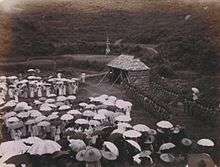Six-Day War (1899)
| Six-Day War of 1899 | |||||||||
|---|---|---|---|---|---|---|---|---|---|
 The British ceremony in Tai Po, 1899, assuming control of the New Territories | |||||||||
| |||||||||
| Belligerents | |||||||||
| Commanders and leaders | |||||||||
|
| ||||||||
| Strength | |||||||||
| More than 525 troops | ~2,600 warriors | ||||||||
| Casualties and losses | |||||||||
| 2 wounded[1] | Several hundred villagers dead[2] | ||||||||
The Six-Day War of 1899 was fought between 14–19 April 1899, by the British Empire and the major punti clans of the New Territories. The British quickly and decisively ended armed resistance, but to prevent future resistance made concessions to placate the indigenous inhabitants. Despite losing to the superior equipped British military they had achieved their ultimate goals which is to preserve their land rights, land use, traditional customs. The special status and rights of the minority Indigenous people of Hong Kong are still seen to this day.
Background
.png)
On 9 June 1898 the British and the Qing government signed the Second Convention of Peking granting the British a 99-Year lease to the New Territories.
Feeling abandoned by the Qing government and fearing for their traditional land rights and land use, the punti Chinese clans mobilised the clan militias[3] which had been trained and equipped to defend against longshore raids by pirates and attempted to resist the British take over of the territory.
Events
The war began on 14 April with the insurgents burnt down the masthead the British had prepared for a flag-raising ceremony at the Flagstaff Hill in Tai Po.
A number of 125 Indian soldiers of the Royal Hong Kong Regiment[notes 1] was sent to Tai Po on 15 April and were soon besieged by the villagers. They were rescued after the Royal Navy's HMS Fame shelled at the insurgents' position.[4] On 17 April the British forces launched an attack on the insurgents in Lam Tsuen Valley and chased them up the hill. On 18 April the insurgents, numbering some 1,600, assaulted the British troops at Sheung Tsuen but was soon defeated. Further resistance was ended when British artillery was brought up against the punti walled villages and the insurgents and villagers surrendered on 19 April. Most prominent of the villages in the resistance Kat Hing Wai, of the Tang clan, was symbolically disarmed, by having its main gates dismounted and removed.
Aftermath
After the war, Governor Henry Arthur Blake adopted an amiable co-operation policy with the villagers and it remained of the official policy of the colonial government on the New Territories throughout almost the entire British rule.[5] The British made the concession of allowing the indigenous inhabitants to retain traditional laws and customs to land inheritance, land usage and marriage, these differed from the laws made for Kowloon and Hong Kong proper and the legacy of which continues to this day.
Notes
- ↑ Disbanded in 1902, this regiment is not to be confused with the later Royal Hong Kong Regiment formed from the body of the Hong Kong Volunteer Defence Corps consisting primarily of Europeans and Chinese.
References
Bibliography
- Hase, Patrick H. (2008). The Six-Day War of 1899: Hong Kong in the Age of Imperialism. Hong Kong: Hong Kong University Press. ISBN 9789622098992.